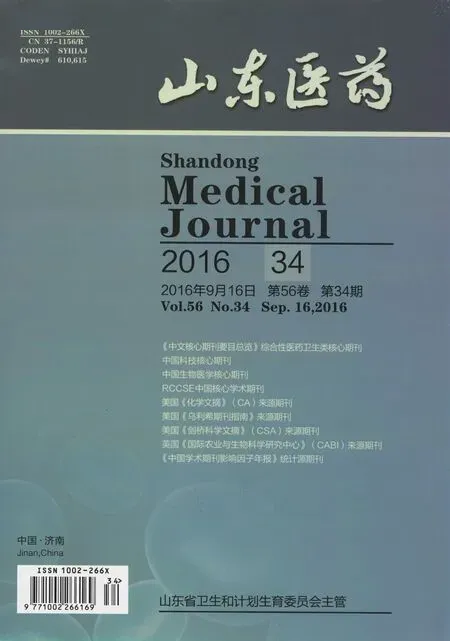1,25-二羟基维生素D3对肠黏膜屏障的保护作用及机制探讨
赵红伟, 韩华, 岳月红
(河北省人民医院, 石家庄050051)
1,25-二羟基维生素D3对肠黏膜屏障的保护作用及机制探讨
赵红伟, 韩华, 岳月红
(河北省人民医院, 石家庄050051)
目的观察1,25-二羟基维生素D3[1,25-(OH)2VitD3]对肠黏膜屏障的保护作用,并探讨其可能的机制,为其在结肠炎治疗中的应用提供依据。方法培养结肠癌Caco-2细胞,模拟人小肠上皮细胞单层细胞屏障;将细胞随机分为3组,A组不处理,B组加2%右旋葡聚糖硫酸钠(DSS)1 mL模拟结肠炎损伤,C组先用10-8mmol/L的1,25-(OH)2VitD3处理24 h再加入DSS 1 mL,干预后培养1 h。透射电镜下观察Caco-2单层细胞屏障超微结构变化,采用免疫荧光染色法检测紧密连接蛋白claudin-1、zo-1和occludin的表达。结果透射电镜下,A组细胞顶部出现排列整齐、分化良好的微绒毛状结构,相邻细胞间的顶端呈现紧密连接样结构;B组细胞局部微绒毛消失或减少,紧密连接样结构消失;C组细胞微绒毛分化较B组好,相邻细胞间的局部微绒毛消失不明显。免疫荧光染色显示,A组3种紧密连接蛋白荧光条带连续完整,荧光强度高;B组紧密连接蛋白荧光条带断续不完整,荧光强度弱;C组紧密连接蛋白荧光条带较清晰连续,且荧光强度增强。结论1,25-(OH)2VitD3可通过增加细胞间紧密连接蛋白的表达发挥其对肠黏膜屏障的保护作用,为其在结肠炎中的应用提供了理论依据。
结肠炎;1,25-二羟基维生素D3;紧密连接;屏障功能
近年来结肠炎在我国呈高发趋势,至今病因末明。肠黏膜屏障是机体最重要的免疫防御屏障系统,其中细胞间的紧密连接蛋白是黏膜屏障的核心组件[1~3],例如occludin蛋白、claudin-1蛋白、zo-1蛋白等。研究表明,结肠炎时肠黏膜通透性增高[4~6]。有研究发现,1,25-二羟基维生素D3[1,25-(OH)2VitD3]可维持肠道黏膜表层的屏障完整性,提示其可能对结肠炎肠黏膜屏障具有一定的修复能力[7]。2010年11月~2011年9月,我们以结肠癌Caco-2细胞模拟人小肠上皮细胞单层细胞屏障,探讨1,25-(OH)2VitD3对肠道黏膜屏障的保护机制。
1 材料与方法
1.1细胞培养与模型建立Caco-2细胞购自中科院上海生命科学研究细胞资源中心,从液氮中取出Caco-2细胞进行复苏。将复苏后的细胞接种在培养液中(含10 %的DMEM),于37 ℃、5% CO2条件的细胞培养箱中培养,每2 d更换培养液1次。第5天后细胞融合达85%~90%时进行细胞传代,传代比例为1∶3。将传代细胞接种在24孔Millicell插入式培养皿(Transwell小室)中,接种密度为4×105/ mL,每孔200 μL;基底侧加入培养液600 μL。接种24 h后更换培养液,隔天换液1次,细胞培养第21~30天体外肠上皮屏障模型形成。
1.2细胞分组与处理 将细胞分成3组,A组不处理,B组加2 %右旋葡聚糖硫酸钠(DSS)1 mL模拟结肠炎损伤,C组先用10-8mmol/L的1,25-(OH)2VitD3处理24 h再加入DSS 1 mL。
1.3单层细胞的超微结构观察取形成体外肠上皮屏障模型的细胞,分组处理同1.2,干预后培养1 h。用4 %戊二醛将单层Caco-2细胞进行固定,以二甲砷酸钠缓冲液进行3次漂洗;漂洗后再用1 %饿酸固定约50 min,在蒸馏水中浸泡20 min;依次用50%、70%、95%、100 %丙酮进行脱水,把细胞浸透在EPons12环氧树脂中过夜;包埋、切片后应用5%乙酰双氧铀镁及柠檬酸铅进行双染,在透射电镜下观察单层Caco-2细胞与细胞之间紧密连接超微结构的变化。
1.4 细胞紧密连接蛋白claudin-1、occludin、zo-1检测采用免疫荧光染色法。取1.1中的传代细胞,分组处理同1.2,干预后培养1 h。用消毒过的PBS漂洗Caco-2细胞3次,每次约5 min;以4 %多聚甲醛固定15~20 min,用PBST漂洗5 min×3次;于5% BSA封闭1 h,用PBST洗5 min×3次;加入浓度为1∶100的鼠抗claudin-1单克隆抗体、occludin单克隆抗体及兔抗zo-1多克隆抗体后4 ℃过夜,用PBST漂洗5 min×3次;孵育对应的荧光二抗(浓度为1∶250的CY3标记的山羊抗小鼠lgG抗体及浓度为1∶50的FITC标记的山羊抗兔lgG抗体),室温避光孵育1 h,PBST漂洗5 min×3次;最后加入DAPI复染,PBST漂洗10 min×3次;应用防淬灭封片剂封片,在荧光显微镜下进行观察及拍照。claudin-1及occludin蛋白发红光,而zo-1蛋白呈现绿光。
2 结果
2.11,25-(OH)2VitD3对单层细胞超微结构的影响在透射电镜下,A组细胞顶部出现排列整齐、分化良好的微绒毛状结构,相邻细胞间的顶端呈现紧密连接样结构;B组细胞局部的微绒毛消失或减少,紧密连接样结构消失;C组细胞的微绒毛分化较B组好,相邻细胞间的局部微绒毛消失不明显,但与A组的紧密连接形态有所不同。
2.21,25-(OH)2VitD3对单层细胞claudin-1、zo-1及occludin表达的影响A组细胞紧密连接蛋白荧光沿细胞胞膜分布,且细胞边缘光滑,呈铺路石形状;细胞之间紧密连接,无明显间隙,强荧光表现。与A组比较,B组细胞紧密连接蛋白荧光强度减弱,分布较分散,边缘粗糙呈锯齿状;细胞之间出现间隙,呈现不连续的线状荧光染色,环断裂甚至崩解。C组细胞紧密连接蛋白的荧光沿胞膜分布,较A组荧光强度稍减弱,无明显间隙,条带较清晰且连续;与B组比较有明显的好转,但与A组比较仍可见细胞间的间隙。见图1。

注:A为A组,B为B组,C为C组。
图1各组Caco-2细胞紧密连接蛋白表达(免疫荧光染色法)
3 讨论
结肠炎是一种慢性非特异性肠道炎症性疾病,严重威胁人们的健康。目前,关于结肠炎发病机制的基本共识是:易感个体在某些环境因素的作用下,肠道黏膜屏障削弱,肠道致病菌群及其有害成分穿过黏膜屏障,与机体免疫系统发生接触并产生过度的级联免疫反应,使炎症反复发生。由此可见,肠道黏膜屏障的损伤与该病的发生有着紧密的联系,故从结肠黏膜屏障保护角度出发为本病的治疗提供了一种新的思路[8~11]。
正常情况下,肠道上皮细胞之间连接组成一道完整的黏膜屏障,可阻止微生物及毒性大分子通过。细胞间的紧密连接是细胞间的重要连接方式,对维持黏膜屏障的完整性起决定作用。因此,肠上皮细胞间紧密连接的破坏及其所致的肠黏膜屏障功能受损在一系列肠道受损疾病的发病机制中起着关键作用[12]。细胞之间的紧密连接是由很多种相关联的蛋白组成,主要包括occludin蛋白、claudin-1蛋白、zo-1蛋白等。其中,occludin蛋白、claudin-1蛋白是构成选择性黏膜屏障的结构蛋白,在肠黏膜上皮细胞的黏膜屏障中起着非常重要的作用。如果这些紧密连接蛋白失活则会引起肠道屏障功能损伤,使肠道黏膜上皮细胞之间的通透性增加[13~15];一些致病细菌穿透肠黏膜屏障,调控上述紧密连接蛋白的表达,破坏细胞间紧密连接结构,损害肠道黏膜屏障功能,从而引起肠道炎症。
1,25-(OH)2VitD3是一种脂溶性维生素,是机体内维生素D的活性代谢产物。其作为类固醇激素参与调节机体的多种生理功能,其中以调节钙磷代谢、促进骨骼生长为人所熟知。近年研究表明,维生素D缺乏会增加患炎症性肠病的风险。维生素D受体(VDR)缺陷小鼠表现为结肠黏膜严重溃疡、伤口愈合不良及肠黏膜单层细胞电阻降低。
Caco-2细胞的结构和功能类似于分化的人小肠上皮细胞,在形态学上具有相同的细胞极性和紧密连接,并可分泌与人体相同的酶类、转化因子等。此细胞来源于人体结直肠癌细胞株,在生长至融合后有柱状突起,是目前较理想的体外肠屏障模型,在紧密连接蛋白表达研究中广泛应用。本研究结果发现,B组Caco-2单层细胞紧密连接样结构消失,claudin-1、zo-1和occludin紧密连接蛋白表达断续不完整且荧光强度弱;1,25-(OH)2VitD3处理的细胞紧密连接样结构有不同程度的恢复,紧密连接蛋白表达条带较清晰连续且荧光强度增强。因此,我们认为,DSS可降低紧密连接蛋白表达,可增加肠上皮屏障的通透性;而1,25-(OH)2VitD3可增加紧密连接蛋白表达,降低肠上皮屏障的通透性,在屏障功能和紧密连接形态的维持中起重要作用,可为临床用药提供理论依据。
[1] Szefel J, Kruszewski WJ, Buczek T. Enteral feeding and its impact on the gut immune system and intestinal mucosal barrier[J]. Prz Gastroenterol, 2015,10(2):71-77.
[2] Michielan A, D′Inca R. Intestinal permeability in inflammatory bowel disease: pathogenesis, clinical evaluation, and therapy of leaky gut[J]. Mediators Inflamm, 2015,2015:628157.
[3] Kamekura R, Nava P, Feng M, et al. Inflammation-induced desmoglein-2 ectodomain shedding compromises the mucosal barrier[J]. Mol Biol Cell, 2015,26(18):3165-3177.
[4] Toumi R, Abdelouhab K, Rafa H, et al. Beneficial role of the probiotic mixture Ultrabiotique on maintaining the integrity of intestinal mucosal barrier in DSS-induced experimental colitis[J]. Immunopharmacol Immunotoxicol, 2013,35(3):403-409.
[5] Salim SY, Soderholm JD. Importance of disrupted intestinal barrier in inflammatory bowel diseases[J]. Inflamm Bowel Dis, 2011,17(1):362-381.
[6] Persborn M, Gerritsen J, Wallon C, et al. The effects of probiotics on barrier function and mucosal pouch microbiota during maintenance treatment for severe pouchitis in patients with ulcerative colitis[J]. Aliment Pharmacol Ther, 2013,38(7):772-783.
[7] Ardizzone S, Cassinotti A, Trabattoni D, et al. Immunomodulatory effects of 1,25-dihydroxyvitamin D3on TH1/TH2 cytokines in inflammatory bowel disease: an in vitro study[J]. Int J Immunopathol Pharmacol, 2009,22(1):63-71.
[8] Hartog A, Belle FN, Bastiaans J, et al. A potential role for regulatory T-cells in the amelioration of DSS induced colitis by dietary non-digestible polysaccharides[J]. J Nutr Biochem, 2015,26(3): 227-233.
[9] Bar F, Bochmann W, Widok A, et al. Mitochondrial gene polymorphisms that protect mice from colitis[J]. Gastroenterology, 2013,145(5):1055-1063.
[10] Dorofeyev AE, Vasilenko IV, Rassokhina OA, et al. Mucosal barrier in ulcerative colitis and Crohn′s disease[J]. Gastroenterol Res Pract, 2013,2013:431231.
[11] Jager S, Stange EF, Wehkamp J. Inflammatory bowel disease: an impaired barrier disease[J]. Langenbecks Arch Surg, 2013,398(1):1-12.
[12] Nowarski R, Jackson R, Gagliani N, et al. Epithelial IL-18 equilibrium controls barrier function in colitis[J]. Cell, 2015,163(6):1444-1456.
[13] Li GX, Wang XM, Jiang T, et al. Berberine prevents intestinal mucosal barrier damage during early phase of sepsis in rat through the Toll-like receptors signaling pathway[J]. Korean J Physiol Pharmacol, 2015,19(1): 1-7.
[14] Ritze Y, Bohle M, Haub S, et al. Role of serotonin in fatty acid-induced non-alcoholic fatty liver disease in mice[J]. BMC Gastroenterol, 2013,13(1):169.
[15] Li X, Akhtar S, Choudhry MA. Alteration in intestine tight junction protein phosphorylation and apoptosis is associated with increase in IL-18 levels following alcohol intoxication and burn injury[J]. Biochim Biophys Acta, 2012,1822(2):196-203.
Protective effect of 1,25-dihydroxyvitamin D3on intestinal mucosa barrier and its mechanism
ZHAOHongwei,HANHua,YUEYuehong
(HebeiGeneralHospital,Shijiazhuang050051,China)
ObjectiveTo observe the protective effect and the mechanism of 1,25-dihydroxyvitamin D3[1,25-(OH)2VitD3] on intestinal mucosa barrier and to provide the basis for its application in the treatment of colitis. Methods Caco-2 cells were cultivated for human intestinal epithelial cell monolayer cell barrier. These cells were randomly assigned to three group: groups A, B and C. Group A was not treated, group B was treated with 2% DSS to establish colitis model and group C first was treated with 1,25-(OH)2VitD3(10-8mmol/L) for 24 hours, then was incubated with 1 mL DSS for one hour. Caco-2 cell monolayers were observed in ultrastructural features by a transmission electron microscope (TEM); and the expression levels of zo-1, claudin-1 and occludin proteins in Caco-2 cells were detected by immunofluorescence. ResultsThere were well-differentiated microvilli structures which were also in good order at the top of cells in the group A, and there was also closely connection between adjacent cells at the top of the structure; while part of the microvilli disappeared or reduced in the group B; the microvilli of cells in the group C were more well-differentiated that those of group B, but part of microvilli disappeared. Immunofluorescence staining showed that in the group A, three kinds of tight junction protein fluorescence strips were complete, and had high fluorescence intensity; those in the group B were incomplete, and the fluorescence intensity was weak; and those in the group C were clear and continuous, and the fluorescence intensity was enhanced. Conclusion1,25-(OH)2VitD3may protect the intestinal mucosa barrier by increasing intercellular tight junction protein expression which also provides the basis for its application in the treatment of colitis.
colitis; 1, 25-dihydroxyvitamin D3; tight junction; barrier function
赵红伟(1979-),女,博士研究生,主治医师,主要研究方向为消化系统疾病的诊断与治疗。E-mail: hongweizhao788@126.com
10.3969/j.issn.1002-266X.2016.34.005
R977.24
A
1002-266X(2016)34-0014-03
2016-03-18)

